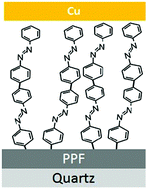Extent of conjugation in diazonium-derived layers in molecular junction devices determined by experiment and modelling†
Abstract
This paper shows that molecular layers grown using diazonium chemistry on carbon surfaces have properties indicative of the presence of a variety of structural motifs. Molecular layers grown with aromatic monomers with thickness between 1 and ∼15 nm display optical absorption spectra with significant broadening but no change in band gap or onsets of absorption as a function of layer thickness. This suggests that there is no extended conjugation in these layers, contrary to the conclusions of previous work. Density-functional theory modelling of the non-conjugated versions of the constituent aromatic monomers reveals that the experimental trends in optical spectra can be recovered, thereby establishing limits to the degree of conjugation and the nature of the order of as-grown molecular layers. We conclude that the absence of both shifts in band gap and changes in absorption onset is a consequence of resonant conjugation within the layers being less than 1.5 monomer units, and that film disorder is the main origin of the optical spectra. These findings have important implications for understanding charge transport mechanisms in molecular junction devices, as the layers cannot be expected to behave as ideal, resonantly conjugated films, but should be viewed as a collection of mixed nonresonantly- and resonantly-conjugated monomers.



 Please wait while we load your content...
Please wait while we load your content...